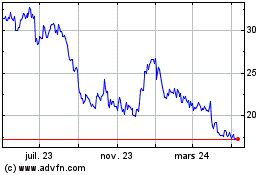CVS and Walgreens hope to offer care to customers needing lots
of it. The challenge: to be taken seriously as health providers;
Doritos and eye exams
By Aisha Al-Muslim and Sharon Terlep
This article is being republished as part of our daily
reproduction of WSJ.com articles that also appeared in the U.S.
print edition of The Wall Street Journal (April 6, 2019).
America's two biggest pharmacy chains are attempting to reverse
their sagging fortunes by becoming go-to treatment centers for
people with chronic illnesses.
CVS Health Corp. and Walgreens Boots Alliance Inc. are
remodeling hundreds of stores into medical-service centers targeted
at customers with conditions like diabetes, heart disease and
hypertension. The idea is to make customers just as likely to stop
in for medicine, consultations and lab tests as for lipstick or a
candy bar.
The need is urgent. Both chains are under tremendous pressure to
find new ways to counter slowing revenue from prescription drugs,
which drive the bulk of their sales. On Tuesday, Walgreens shares
fell 13% after it gave a gloomy full-year earnings outlook, weeks
after CVS did the same. CVS shares have fallen 34% since its $70
billion acquisition of insurer Aetna Inc. as its has struggled to
convince investors the combination will prove lucrative.
Drug-pricing pressure isn't letting up. Both companies are
getting hurt as generic-drug makers scale back price cuts and
pharmacy-benefit managers squeeze pharmacies across the board on
both generic and brand-name drugs.
Meanwhile, looming over both Walgreens and CVS is Amazon.com
Inc.'s foray into prescription-drug sales. Amazon said last year it
was buying online pharmacy PillPack Inc. for about $1 billion, a
move that factored into CVS's decision to acquire Aetna, people
familiar with the situation said at the time. Walgreens cited
Amazon's PillPack deal as a potential threat to its business in its
latest annual report.
"It's clear that the drugstores that we are used to knowing will
not be the store of the future for sure, so we have to change,"
said Walgreens Chief Executive Stefano Pessina in a recent
interview.
But previous attempts to remake the drugstore concept with
in-store medical services have had mixed results -- and led to a
high-profile embarrassment for Walgreens, whose disastrous
partnership to offer in-store blood testing with now-defunct
Theranos Inc. ended in a legal settlement in 2017.
Walgreens declined to comment on its venture with Theranos,
which has been engulfed by charges it deceived investors about the
capabilities of its technology, beyond saying the deal was done
under previous management.
Now, the chains are focused on a challenge that has long
frustrated the broader U.S. health-care system: getting patients
with chronic diseases to take better care of themselves.
Roughly 60% of Americans have at least one chronic condition and
four in 10 adults have more than two, according to the U.S. Centers
for Disease Control and Prevention. Many patients have trouble
taking their medicines as prescribed and slip back into poor health
habits -- or go untreated until they end up in the emergency room.
The CDC estimates that chronic conditions account for roughly 90%
of the nation's $3.3 trillion in annual health-care spending, much
of it for in-hospital care.
CVS and Walgreens say their vast networks, the ease of access
and the data they collect on pharmacy customers make them uniquely
positioned to help those with chronic conditions comply with their
treatment plans.
"It's bringing more health services to a more convenient
location that doesn't disrupt your day and has a consumer bent to
it," said Alan Lotvin, CVS chief transformation officer. "We
inculcate it into your everyday routine so it's not, 'Oh I'm going
to the doctor today.'"
The gains could be big in getting people needing costly
medicines to actually fill their prescriptions, not least for CVS
who could leverage Aetna's insurance savings from reduced
health-care costs. For both pharmacy chains, it could help increase
both prescription income and foot traffic to stores.
But there are a lot of obstacles, perhaps the biggest of which
is getting customers to take the drugstore chains seriously as
health-care providers.
"It's mind boggling to me that they can say the center of the
health-care system will be a retail outlet that sells Doritos as
well as prescription drugs," said Lawton Burns, a health-care
management professor at the University of Pennsylvania's Wharton
School of Business.
Others say the chains could have an edge over health systems and
hospitals that have long tinkered with ways to improve access to
care for the chronically ill.
"The current solutions aren't working," said Sanjay B. Saxena,
who works with insurers and health systems at Boston Consulting
Group. "We aren't addressing the fact that health care has not
caught up with the rest of what consumers expect in their life.
Chronic disease keeps getting worse and the costs associated with
that are going up."
CVS sees roughly 1,000 of its more than 9,800 retail stores
becoming bigger hubs, offering a range of medical services, while
Walgreens envisions a similar setup for about 1,500 of its 9,600
U.S. locations. Those locations -- CVS calls them "health hubs" and
Walgreens terms them "neighborhood health destinations" -- will
anchor a broader network of more traditional drugstores that will
be tweaked to focus more on health and less on traditional
retail.
Walgreens has struck partnerships with about a dozen companies
in recent years on ways to monitor patients' health and behavior,
and advise them accordingly. With partners, it already has some 400
clinics inside stores, with treatments such as flu shots
administered by nurse practitioners, and more than a dozen
urgent-care centers.
Microsoft Corp. is helping Walgreens develop software that would
manage patient engagement, while Alphabet Inc.'s Verily Life
Sciences unit will develop a pilot project to get patients to take
their medications as prescribed. Walgreens has also opened two
in-store primary-care clinics in the Kansas City area with insurer
Humana Inc. and has replaced its ill-fated Theranos partnership
with a blood-testing deal with clinical-lab operator LabCorp to
open at least 600 centers at Walgreens stores over the next four
years.
Mr. Pessina, the CEO, says data collected by Walgreens can
ultimately be used to flag unhealthy behaviors in consumers. Among
Walgreens' new features will be an app that encourages customers to
log their diets and other information and that alerts users to the
consequences of their choices.
That fright factor will encourage people, such as diabetics not
following their recommended diet, to make better choices, Mr.
Pessina said, including taking prescriptions regularly and keeping
up with recommended diagnostics.
Walgreens has opted for partnerships over big acquisitions,
which Mr. Pessina said carry too much risk.
CVS, meanwhile, wants full control over its assets. That
thinking drove the chain's Aetna acquisition, as well as its deals
for the walk-in MinuteClinic chain and pharmacy-benefits manager
Caremark more than a decade ago.
"These systems and operations can talk to one another, we can
set the culture," said Kevin Hourican, president of CVS Pharmacy,
who oversees the company's retail operations.
Aetna is central to its latest mission. With access to its
insurance rolls, CVS pharmacists will be able to reach out directly
to customers with chronic health conditions and encourage them to
come to the store for a consult on services they can access. If
CVS's approach works, Aetna's data can then be used to demonstrate
savings and, the company hopes, woo other insurers into using its
model.
Also central to the plan is an overhaul of the MinuteClinic
network.
Today, roughly 1,100 MinuteClinic locations, located inside CVS
pharmacies and Target stores and staffed primarily by nurse
practitioners, address immediate and simple health issues, such as
flu shots or treatments for a sore throat. CVS is aiming to shift
the clinics toward managing complex and chronic cases, for example
equipping them with retinal imaging systems to carry out eye exams
that are part of annual physicals recommended for diabetics.
But wading deeper into health care, particularly complicated
chronic conditions, could put the companies at greater risk of
medical malpractice claims, said Nicholson Price, a professor at
the University of Michigan Law School who has written on health law
and ethics.
Patients today don't interact much with their pharmacists, Mr.
Price said, so building a system in which pharmacists aid in
carrying out treatment is a big shift. "Once you get into more
actively managing chronic conditions you start to ask, 'Would a
physician's assistant or nurse practitioner be expected to
recognize some sort of complications that are arising?" he
said.
Shirlette Williams, a Type 2 diabetes patient in Buffalo, N.Y.,
says she couldn't fathom using a drugstore as her medical provider.
The 54-year-old says she relies on a combination of a health clinic
near her home and regular visits with a diabetes educator and
nutritionist, and that she would question a drugstore's motives in
treating her condition.
"I wouldn't go to CVS or Walgreens to manage my condition
because I feel that a drugstore's priority would be to sell me
drugs," Ms. Williams said. "While the idea could be a good one for
people who don't have a health-care provider in their neighborhood,
I'd feel more confident if my pharmacy and health-care provider
were separate entities."
Both companies say people who have visited stores with the new
format have responded positively and that further changes will help
consumers make the leap more confidently.
"Care coordination with our pharmacists and patients' providers
is often critical to better outcomes, and benefits all parties
including patients, payers and providers," a Walgreens spokesman
said.
Both companies say they will comply with health-privacy laws and
won't share data with the retail side of the business.
CVS says its existing capital budgets will cover costs of
reinventing stores nationwide. A Walgreens spokesman said
investments would be made "in a financially disciplined manner,"
declining to further quantify.
Unlike CVS, which stopped selling tobacco products in 2014,
Walgreens has continued to sell cigarettes in most of its stores,
drawing criticism from federal regulators, lawmakers as well as
activists who say that tobacco products don't belong in a health
store. Mr. Pessina says the chain is testing some tobacco-free
stores and is encouraging employees in others to offer aids to quit
smoking to customers buying cigarettes.
One recent weekday afternoon, Mr. Pessina, the company's CEO,
walked through a store near the company's Deerfield, Ill.,
headquarters. In an area called the "health corner" were signs for
optical, lab, hearing and pharmacy services. As Mr. Pessina quizzed
the in-store optometrist about the number of visitors he was
getting, a customer shuffled by pushing a shopping cart with a case
of Bud Light. Across the store, a woman had her blood pressure
checked.
Mr. Pessina said he's convinced moving away from traditional
retail is the only way forward. "We are also a retailer," he said.
"But we are above all a pharmacy."
Write to Aisha Al-Muslim at aisha.al-muslim@wsj.com and Sharon
Terlep at sharon.terlep@wsj.com
(END) Dow Jones Newswires
April 06, 2019 02:47 ET (06:47 GMT)
Copyright (c) 2019 Dow Jones & Company, Inc.
Walgreens Boots Alliance (NASDAQ:WBA)
Graphique Historique de l'Action
De Mar 2024 à Avr 2024

Walgreens Boots Alliance (NASDAQ:WBA)
Graphique Historique de l'Action
De Avr 2023 à Avr 2024
